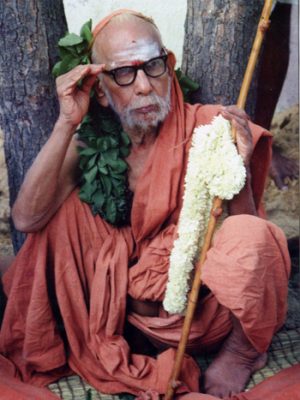
The ‘Tiruvembavai’ is one of Manikkavachagar’s most famous poems. Indeed, judging by the number of commentaries that have been written on it and from the number of meetings that are held to expound its meaning, it can justly be regarded as one of the most famous poems ever written in Tamil. Part of its fame can be attributed to its mystical obscurity, which has inevitably prompted a large number of differing explanations, but one cannot ignore the contribution made in recent times by the former Sankaracharya of Kanchipuram, Sri Chandrasekharendra Saraswati Swami. The poem was a particular favourite of his, and he did much to encourage public awareness of it. Sri G. Vanmikanathan, who was personally encouraged to write commentaries on the Tiruvachakam by the Sankaracharya, has written that, each year, in the Tamil month of Margazhi, the ‘Tiruvembavai’ poem is sung throughout the length and breadth of the Tamil-speaking world and ‘conferences and meetings in hundreds are held in that period to expound it’. (Pathway to God through the Tiruvaachakam, by G. Vanmikanathan, pp. 217-218.) Now that the Sankaracharya has passed away, the meetings are far fewer, but the poem still remains a favourite of millions of devotees, and it is still widely recited in the early morning in the month of Margazhi. During Bhagavan’s lifetime there was a special early morning parayana during Margazhi when devotees chanted ‘Tiruvembavai’ and other poems of Manikkavachagar.
Though it has a distinguished place in Tamil literary history, and a strong local connection, there is only one recorded instance of Bhagavan citing a portion to a devotee. (My Recollections of Bhagavan Sri Ramana, by Devaraja Mudaliar, p. 52)
Even as the gems that thickly cluster
upon the crowns of gods on high,
when they bow down, will lose their lustre
before the lotus feet of Lord Annamalai,
likewise the sun, with bright-eyed gaze
dispels the darkness with his rays,
making stars flee, their cool light fade.
Thus does He [Siva] stand before us
as woman, as man, as androgyne,
as the space that co-exists with the effulgent sun and moon,
as earth, yet from all these separate,
ambrosia to the eye made manifest.
So sing you then of His holy feet, O Maid,
and in the flowery flood, plunging, bathe!
El or empaavai! (‘Tiruvembavai’, verse 18)
The young girl who is addressed is being encouraged to go to Siva, sing His praises, and merge in His feet. The final line, which has no particular meaning, is generally held to be a cry made in children’s games of that era.

Suri Nagamma has reported that Ramaswami Pillai once recited this verse to Bhagavan at the end of the usual Tamil parayana. Bhagavan had wanted to get up and leave, but Ramaswami Pillai knew that he could probably detain Bhagavan for a few extra minutes since he knew that this was one of his favourite verses. (Letters from Sri Ramanasramam, by Suri Nagamma, 13th December 1946)
Bhagavan told Devaraja Mudaliar (My Recollections of Bhagavan Sri Ramana, p. 52) that he particularly appreciated the line in this verse which states that Arunachala-Siva is ‘ambrosia to the eye made manifest’. Devaraja Mudaliar has also reported that Bhagavan also liked a very similar phrase that appeared in ‘Potritiruvahaval’:
Annamalai, our Father,
praise be to you!
Ocean of nectar that delights our eyes,
praise be to you!